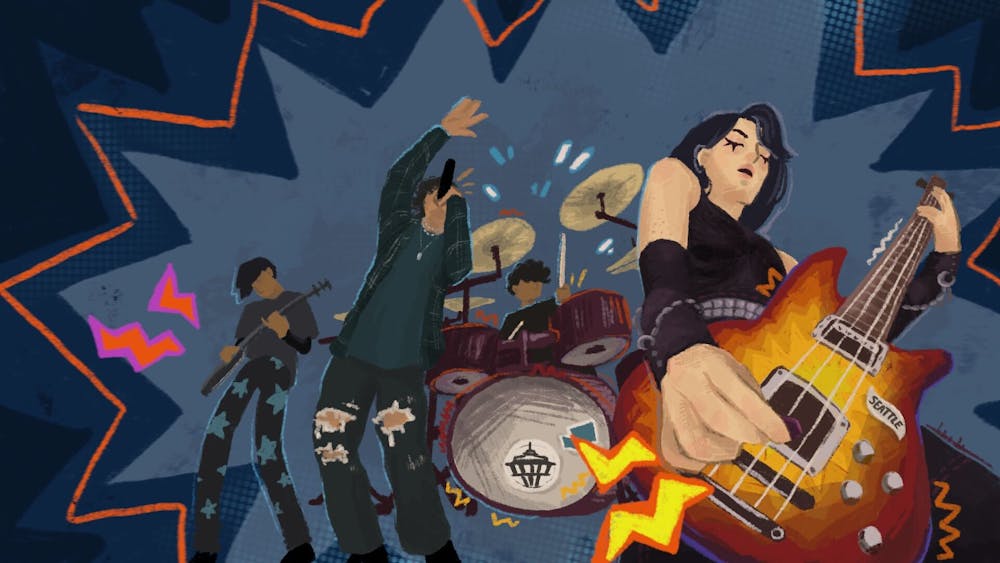Nirvana—the band famous for its soul–scarred catharsis, cult following, and demonic–looking smiley face plastered on virtually all Newbury Comics merchandise.
Nirvana embodies the genre we know as “grunge,” whose origin can be traced to the inauspicious heart of the Pacific Northwest—Seattle, Wash.
But what could be so special about a place that is otherwise known (by myself, at least, a native New Englander) only for its unfortunate weather, surplus of ferry boats, and Grey’s Anatomy? Seattle’s relatively small population, combined with its distance from major artistic epicenters, could at first glance be considered an unlikely source for musical innovation, especially when compared to the standard culture capitals of the country. In reality, it was exactly these features that allowed musical groups like Nirvana, Alice in Chains, and Pearl Jam to absorb and embrace every variant of rock and roll.
“Grunge” has a collection of less endearing definitions. Colloquially, it literally means “dirt” or something particularly repugnant—and as far as its musical style goes, that's really not too far off. Gritty vocals and roaring Marshall amps define this genre, alongside loose morals and a rebellious spirit. But really, grunge lacks a clear definition, and if you were to ask legends of the genre themselves, they might be averse to the term, preferring instead to not be restricted to a singular brand. Soundgarden guitarist Kim Thayil puts it best, “‘Grunge,’ as a term, nobody liked that. Everyone thought, ‘Oh this is a marketing thing. This is a way to file Seattle on a retail display in a record store.’” But if there's anything we know about labels, it’s that most musicians seem to resent them.
Grunge bands made inroads into the musical mainstream in the late 1980s, but it was the success of Nevermind that surprised the music industry, popularized grunge, and established the cultural and commercial viability of alternative rock. Perhaps most importantly, the representation of grunge music in the media served to depict Seattle as a community whose focus was the ongoing exploration of a single musical style.
And, of course, as with all modern art, the label of “grunge” was generalized to create a market for merchandise: grunge fashion, grunge air freshener, grunge hair gel. The works.
But the most significant reasons for grunge’s genesis extend beyond Seattle’s dismal atmosphere to its more overlooked characteristics, such as its economy, geography, and politics.
The literal isolation of the Pacific Northwest was excellent fuel for innovation, and its distance from Los Angeles—an epicenter of arts and popular expression/culture—meant that Seattleites were untouched by and uninformed of the latest musical trends. Touring bands would routinely skip the region, as the trouble of traveling so far outweighed the size of the market. Left to their own devices, musicians in the region had to make their own magic.
Seattle was also poor. A series of economic shocks in the 1970s left the area a disadvantaged, working–class–dominated hinterland. The grunge “aesthetic” was based, in large part, on the economic realities of the time. Trucker hats and pawnshop guitars were not mere stylistic choices, but accessories indicative of the economic realities of the region. Even Kurt Cobain himself was living in his car when the chart–topping Nevermind was released. The “John Lennon of the swinging Northwest” was no exception to the harsh conditions that gave rise to this genre.
Moreover, the area’s counter–culture values were a major source of artistic inspiration for grunge artists. 1980s and ’90s Seattle harbored a swath of American youth eager to embrace anti–establishment attitudes and reject their destinies as cogs in a corporate machine. The greatest artistic and developmental influences for Seattle artists came from metal and punk—genres which undoubtedly possess similar non–conformist sentiments.
Maybe in some twisted Orwellian reality, we could replicate the conditions of Reagan–era Seattle to create similar musical innovation. Regardless, it's clear that the conditions of the late 20th century Pacific Northwest were conditions that demanded a level of cultural clarity. Innovation demands inspiration but also privacy and a space to evolve.
In essence, the Seattle grunge scene was a freak musical anomaly fueled by exclusion from the mainstream and poor economic conditions that planted the seeds of cultural expression. What does this combination of qualities say about our ability to create new genres, new songs, and new cultural movements? Perhaps these conditions are not just necessary for musical innovation, but other political and social upheavals. The noise–inflected garage bands of poverty–ridden adolescents in 1980s Seattle might compare with the Dadaist movement of early 20th century Switzerland, or the images of Progressive Era photographers who lent their skills to industrial reform. Art imitates life, just as the Seattle grunge scene embodied the circumstances of its creators.







